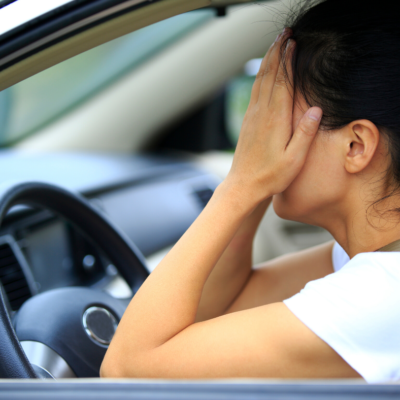Does the thought of driving down the highway or in heavy traffic make your heart race?
Driving anxiety is a very real and disruptive fear for many Canadians. Symptoms can range from uneasiness to a full-fledged panic attack, and for those dealing with driving anxiety, getting behind the wheel can be one of their biggest fears.
In Canada, our primary mode of transportation is automobiles. Getting from one end of a city to another, or reaching smaller rural communities is often only accomplished by driving. Our cities are spread out, making travel by foot often difficult. Though it’s possible to use public transportation, accessibility is more limited when compared to major metropolitan cities in Europe or the States.
In short, when living in Canada, there is a pretty good chance that you will need to drive.

The Anxiety and Depression Association of America listed the top 5 causes for driving anxiety. By understanding the potential cause of your nervousness being in the driver’sseat, you can slowly begin to find strategies to manage these emotions.
The Top 5 Driving Anxiety Causes:
- Past Negative Experiences: This includes a traumatic car accident, being a victim of road rage, getting lost, or driving through a bad storm.
- Driving Alone Outside of One’s Comfort Zone: For many drivers, the ease of driving around their local neighbourhood or to the grocery store and back is no problem. But navigating down unfamiliar roads, such as a downtown core, can create a lot of stress.
- Fear of Having a Panic Attack in Traffic: If you are prone to panic attacks, the mere thought of being stuck in traffic while having one can make you apprehensive of even getting in a car.
- Fear of Losing Control: Watching vehicles zip past you on the highway can make you tighten your grip on the steering wheel. Though you may feel pressured to drive faster down the highway, the fear of you or someone else on the road losing control may cause you to drive substantially slower than the speed limit. This can put you as well as other drivers in a potentially dangerous situation.
- Fear of Fatalities: Driving anxiety is often caused by a person underestimating their ability and exaggerating the dangers of being on the road. The worst case scenario is what floats to the forefront of a person’s mind. You don’t have to be a victim of a car accident to imagine being in one.
Symptoms of Driving Anxiety
Driving anxiety can manifest in several different ways, as shared by Desjardins Insurance. Symptoms may include:
- Avoiding driving completely
- Heart palpitations
- Trembling
- Sweating
- Dizziness
- Dry mouth and throat
- Feeling faint
- Difficulty breathing
- and more
Driving anxiety is not only a very emotional experience for the person encountering these symptoms, but it can also put their own life and the lives of others at risk.
If you are experience driving anxiety, there a a few strategies and tips available to help you overcome this fear and become a more confident driver on the road. Psychology Today stated in a recent article that cognitive behavioural therapy (CBT) as one of the most effective ways to treat driving-related panic attacks. CBT includes using a few techniques to help you face your fear instead of avoiding it

If you want to start taking control over your fear of driving, give these 3 tips a try:
- Face Your Fear
Slowly exposing ourselves to our fears is a powerful way to retrain your brain and nervous system. The more we practice doing the things that make us uncomfortable, the better we get at managing our emotional response and teaching our body that it doesn’t need to panic. To begin, go on easy, 5 to 10-minute drives around your neighbourhood. Over time, increase the distance you drive away from home and your minutes on the road.
- Focus on the Present
Those with driving-related anxiety are often thinking about the whole trip ahead before they even pull out of their driveway. By doing this, you are trying to anticipate what is to come like bridge crossings, high-traffic areas, and worrying about different scenarios. Though we may think that this “pre-planning” is a good idea, it can cause the brain to feel overwhelmed, triggering anxiety.
Instead of mapping out the entire drive, focus on the present moment. Think only about what is in front of you, and manage only one section of your trip at a time. This takes practice as the brain likes to jump ahead and stay busy. But if you focus on one portion of the journey at a time, it feels less overwhelming and more attainable.
- Focus on Symptoms, Not the “Stories” Behind them
If while you are driving, you begin to experience a panic attack, pull over when it is safe to do so. Turn on your hazard lights (safety first!) and then focus on controlling your physical symptoms. You can do this by taking slow, deep inhales and exhales. If your hands are trembling, shake them out, and if you feel hot or sweaty, turn on the AC.
Close your eyes, and remind yourself that these symptoms are temporary and will go away. Try your best to avoid thinking about your fear and just focus on your breathing. This will help to calm your nerves. As soon as we start thinking about our fear, a physical reaction can arise in the body. By learning how to control those emotions, we can slowly develop techniques to overcome our anxiety on the road.
If you’ve experienced a panic attack while behind the wheel, or are worried about having one, it might be a good idea to speak to a therapist. They can share useful strategies and tips to help you cope with driving anxiety.
Remember, this is a common fear amongst Canadians. However, with a little practice and by facing your fears head-on, you can become a confident driver on the highway.
If you happen to get in a car accident while in Alberta, give our team at McGuiness Law a call for a free consultation. We cover all costs, with no fee unless we settle in your favour.